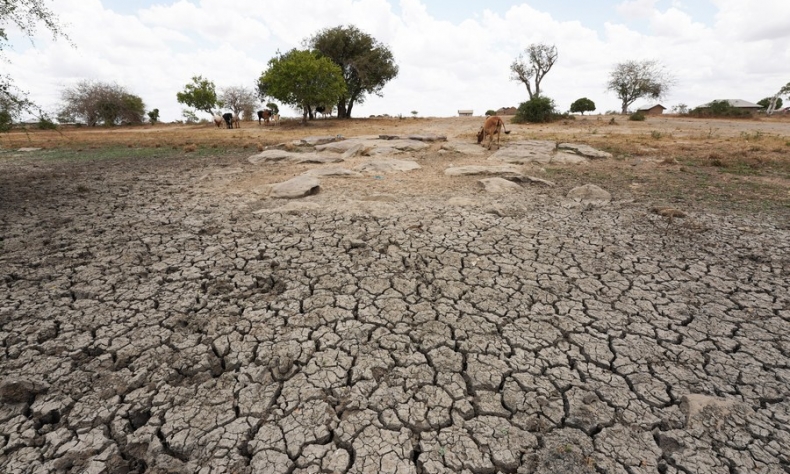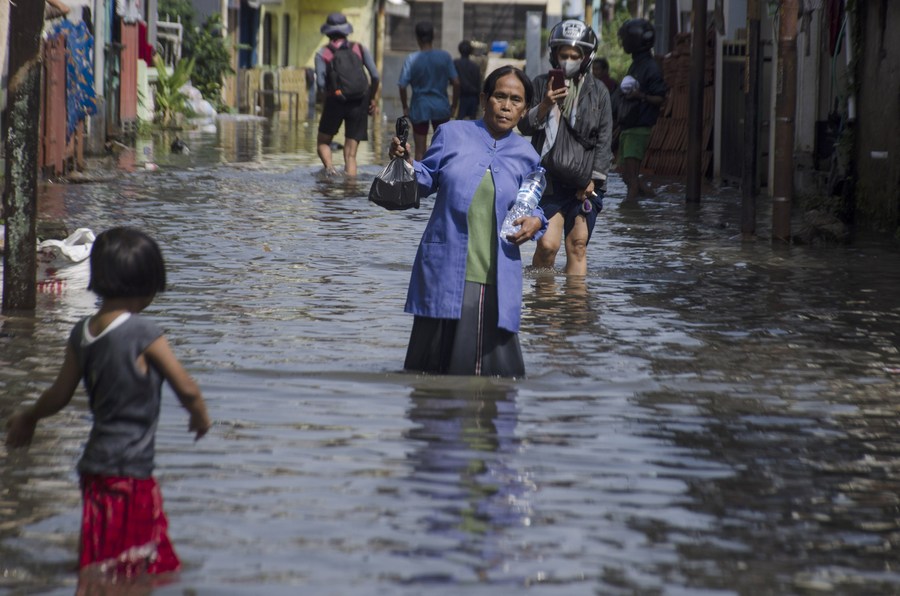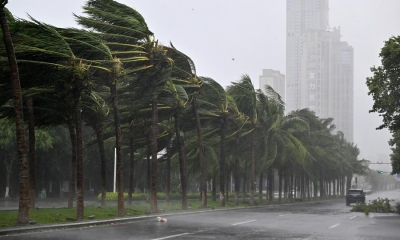Climate Change: No Going Back

With a commitment to reduce emissions, and its investment in green technology bringing down global costs, China is emerging as the leader in fighting climate change.
Everybody knows that our world is getting hotter. They also know why. Pumping out pollutants has transformed our world into a greenhouse; heat from the sun is now trapped by a “dirty” atmosphere.
Yet the principal polluters are unwilling to stop, or to stop sufficiently quickly. Nor are they prepared to pay enough to protect people affected, saving lives. Evidence of the costs of inaction are everywhere.
2024 is expected to be the warmest year on record. 2023 had previously been the warmest year.
As the atmosphere heats, it holds increasing amounts of water. It is like a big sponge, with the holes containing water increasing in size as temperatures rise. This means that the atmosphere retains water for longer, causing droughts, and drops more water when it rains, creating floods and landslides. Each additional degree of global warming increases extreme daily rainfall by seven percent, according to the World Meteorological Organization (WMO).
Last year witnessed severe droughts in much of South America, southern Africa and the Zambezi basin, the Mediterranean and eastern Europe. Significantly below average rainfall fell in China, Cambodia, Laos, Myanmar, Malaysia, Thailand, and Vietnam.
Equally floods were widespread, occurring in Central Asia, East Africa, West Africa, Southeast Asia, and Central Europe. Exceptional snowmelt resulted in unprecedented flooding in Kazakhstan and monsoon rains inundated parts of Bangladesh, India, Nepal, and Pakistan.
The atmosphere would be even hotter had the ocean not absorbed 93 percent of the additional heat created since industrialization. However, warmer oceans fuel more powerful hurricanes and typhoons including storms Beryl, Helene and Milton that devasted parts of the southeast of the United States in 2024. The super typhoon Yagi that tracked across Vietnam, Myanmar, Laos, and Thailand left over 500 deaths in its wake.
Sceptics claim that climate change has nothing to do with human activities. Carefully conducted science refutes that contention. As of November 2024, 612 attribution studies had been conducted on 735 extreme climate events. Analysis indicated that 74 percent of the events had been made more likely, or worsened, by human induced climate change. Some events, scientists concluded, could never have occurred without human influence.
The human costs of climate change are staggering. Since 2008, when records were first collected, 359 million people have been forced to leave their homes, either permanently or temporarily, by weather related events. According to the 2024 Global Report on Internal Displacement, 6.6 million people were displaced in 2023 alone due to floods, storms, drought, and wildfires; indeed, because some people were forced to move multiple times, over 20 million separate displacements occurred.
The WMO reports that, between 1970 and 2021, 11,778 disasters attributed to weather events and water extremes caused 2.1 million deaths and resulted in economic losses of US $4.3 trillion. Ninety one percent of these climate-related deaths occurred in developing countries where 83 percent of the world’s population lives – up from 73 percent in 1980. While deaths have fallen by over two-thirds since the 1980s, mostly due to better warnings, the economic cost has increased almost five-fold.

Looking forward, the World Economic Forum predicts a further 14.5 million deaths attributable to climate change by 2050, 8.5 million due to floods, and 3.2 million because of drought.
All humanity, one might assume, would want to prevent these deaths. This is possible through better prediction, adaptation to prevent the worst consequences of climate-induced disasters, and by mitigation, reducing the emission of greenhouse gases. Indeed, a United Nations framework – the UN Climate Change Conference – has existed since 1995 to do this.
The Kyoto Protocol agreed upon in 1997 established legally binding obligations for developed countries to reduce their greenhouse gas emissions. Yet carbon emissions in 2024 were the highest ever.
With the Paris Agreement in 2015, the 195 signatories approved a system of nationally determined contributions. Each signatory government must specify how they will contribute to lessening the effects of climate change by reducing emissions and adopting measures such as adaptation, technology transfer or capacity building. Every five years they are required to increase their contribution.
Mitigation and adaptation cost money. The Climate Change Conference (COP29), held in Baku, Azerbaijan in November 2024, needed to determine how this cost would be apportioned between rich and not so rich countries. In a fair world, polluters would be expected to pay for the consequences of their pollution.
Historically greenhouse gas emissions have been associated with industrialization and development. The European Commission estimates that 77 percent of total CO2 emissions released since 1850 have been produced by the G20 grouping of large economies, a value that falls to 50 percent when the newly industrialized countries of Brazil, China and the Russian Federation are excluded. In comparison, the 45 least developed countries are together responsible for just four percent of historic emissions.
Today, the situation is somewhat different. In 2023, Brazil, China and the Russian Federation together accounted for 45 percent of greenhouse gas emissions, while post-industrial economies, the U.S. and European Union, contributed 11 percent and six percent respectively. Per capita emissions in the U.S., though, are still 64 percent higher than in China.
In 2015, developed countries committed to mobilizing US $100 billion of climate finance each year to assist developing countries in mitigating and adapting to climate change. The plan was that they would achieve this by 2020 and then agree, by 2025, to continue mobilizing this amount or to increase it. This decision was under consideration in Baku.
The OECD reports that US $100 billion was raised by 2022, two years behind schedule. But, this claim is contested. There is no universally agreed definition of what should count as “climate finance.” Sums claimed by donors include funding diverted from existing development assistance budgets and are therefore not additional. Over half of the funding takes the form of loans, with perhaps a fifth taken out at market interest rates. Loans add to developing countries’ indebtedness.

While adaptation can reduce the damage resulting from extreme climate events, it will not eliminate it. The US $100 billion of agreed climate finance did not cover loss and damage. Agreement was reached at COP27 in Sharm El-Sheik, Egypt, to establish a loss and damage fund. At COP28, in 2023, Germany among others pledged funding of US $100 million, the European Union US $245 million, and the United States US $17.5 million. With this funding being inadequate when set against need, the fund was also on the Baku agenda.
The investment needs of developing countries in accommodating to climate change are well established: US $1.3-1.4 trillion for China plus US $2.4 trillion per year by 2030 for other emerging markets and developing countries. These figures, from the Independent High-Level Expert Group on Climate Finance established by the United Nations, are “analytical deductions, not a ‘first bid’ in a negotiation.”
Therefore, developing countries had science on their side when they entered negotiations in Baku requesting that the new climate finance goal (NCQG) be US $1.3 trillion rather than US $100 billion. They also hoped to include loss and damage in the goal to ensure that funding continued and, failing that, regular reporting on loss and damage expenditures.
Led by the G77 and China negotiating group, developing countries rejected outright the initial draft negotiating text. They held out on reaching agreement until after the Conference was scheduled to end when developed countries finally agreed to taking the lead in raising at least US $300 billion per year from 2035.
Loss and damage were not included in the agreement, 2035 is a decade away, and there is no firm pledge from developed countries on actual contributions. ‘Taking the lead’ steps back from the 2015 commitment of ‘providing.’ This unbridged gulf between need and response will undoubtedly cost many lives.
However, with European countries reducing development aid, and the possibility of the United States withdrawing from the UN climate process – as it did under the first Trump administration, there needed to be a deal to protect developing countries.
Zhao Yingmin, head of the Chinese delegation at Baku, explained that, regardless of changes in the geopolitical landscape, China would promote international cooperation on climate change.
Moreover, China’s vice premier Ding Xuexiang revealed that, since 2016, China has already provided US $24.5 billion to support other developing countries in combatting climate change. Independent research suggests that China’s contribution equals that of the U.K. and is exceeded only by Japan, Germany, the United States, and France.
With a commitment to reduce emissions, and its investment in green technology bringing down global costs, China is emerging as the leader in fighting climate change.
 Facebook
Facebook
 Twitter
Twitter
 Linkedin
Linkedin
 Google +
Google +







